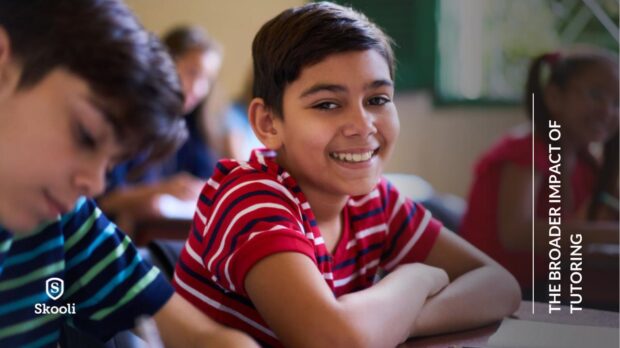The Broader Impact of Tutoring: Serving ELL Student Populations
According to recent statistics from the National Center for Education Statistics, data from 2019 shows English Language Learners (ELLs) comprised 10.4% of the K-12 student population.
Across the country, numbers of ELLs in fall 2019 “ranged from 0.8 percent in West Virginia to 19.6 percent in Texas.”
While Spanish is the language most commonly spoken in the homes of ELLs, Spanish-speaking students are certainly not the only population of students for whom English is not the first language. Across the US, Arabic ranked second with Chinese and Vietnamese tying for third.
These numbers are not surprising, and the upward trend is expected to continue.
According to the National Education Association, “By 2025, 1 out of 4 children in classrooms across the nation will be an English language learner (ELL) student.”
For this growing population of students whose first language is not English, performing at or above standard expectations is a struggle.
Compound this by the impact of Covid-19. Research has shown the pandemic’s significant negative impact on progress and learning. Brookings has reported that:
“Average fall 2021 math test scores in grades 3-8 were 0.20-0.27 standard deviations (SDs) lower relative to same-grade peers in fall 2019, while reading test scores were 0.09-0.18 SDs lower….
Even more concerning, test-score gaps between students in low-poverty and high-poverty elementary schools grew by approximately 20% in math (corresponding to 0.20 SDs) and 15% in reading (0.13 SDs), primarily during the 2020-21 school year. Further, achievement tended to drop more between fall 2020 and 2021 than between fall 2019 and 2020 (both overall and differentially by school poverty), indicating that disruptions to learning have continued to negatively impact students well past the initial hits following the spring 2020 school closures.”
In addition to this data, a report from UnidosUS, the nation’s largest Latino civil rights organization, “found that the Covid-19 pandemic had a disproportionate impact on most Latino students, but especially on those learning English.”
During the Covid learning years, the rate at which ELLs failed to read at grade level was 1.5 times higher than their peers, according to 2021 data from the U.S. Department of Education.
Even without the learning gaps exacerbated by the Covid-19 pandemic, assessment scores of students whose first language is not English have lagged behind.
NCES data (prepared in November of 2019) shows the deviations in reading scores of ELLs on the National Assessment of Educational Progress (NAEP) reading scale below those students who were not ELLs.
Much attention has been given to the need to provide interventions to help students bridge the learning gap of the Covid-19 years.
But among the ELL student population where gaps already existed, even more obstacles to bridging learning loss must be overcome.
For example, the UnidosUS report says that ELLs “also experienced 3% higher rates of disengagement than their peers during the pandemic, the DOE found.”
How can your district support these students not only to help them close the learning gap but also to help them re-engage?
ELL students are often the ones who need additional supports simply to help them gain equitable access to a quality education.
They are often less likely to have parental support, whether it is support in finding help with homework or placing a higher priority on education overall.
Parents who are themselves not fluent in English and who did not attend school in the US may not know how to help when they see their children struggling.
Supporting these subsets of your district’s student population can have a great impact not only on the students and their academic success but also on the students’ families and their broader community. When you support ELL learners, you are showing the students, their parents, their extended family members and all others in their community that you value these students and are committed to providing support and access.
Where does tutoring fit in?
Tutoring, as a research-proven intervention, can support all diverse learners, including ELL students.
With support from professional tutors, students have equitable access to education. They also can receive individualized learning instruction that is designed to address the student’s needs to help close learning gaps.
Skooli tutors are experts in best practices and in providing supports for all learners. Our extensive network of educators hold teaching licenses and/or Master’s or PhDs.
Skooli offers schools, districts and organizations an equitable and affordable online tutoring platform to address learning loss through 1:1 academic support across over 122 subjects.
By making professional on-demand tutoring available to all students, your district will help build a sense of community not only for the students but for their families and the greater community.
An important feature to highlight that benefits ELL students is Skooli’s audio feature: this feature allows tutors and students to speak with each other directly over the platform. In combination with the whiteboard, communication is made as easy possible so that students can end a tutoring session feeling confident.
Skooli also offers a video feature which is optional at the district level and at the student level.
As an ELL, these accessibility features pre-emptively lessen the frustration that can be caused by a language barrier.
When tutoring really took off during the pandemic, we learned that solely text-based exchanges are ineffective.
Axios quoted Amalia Chamorro, director of education policy for UnidosUS, as saying, “As we emerge from the pandemic, which we know really hit the community of Latinos very strong, our goal should be to create an educational experience and reimagine what education can look like.”
Let Skooli help your district reimagine the educational experience for your students.

